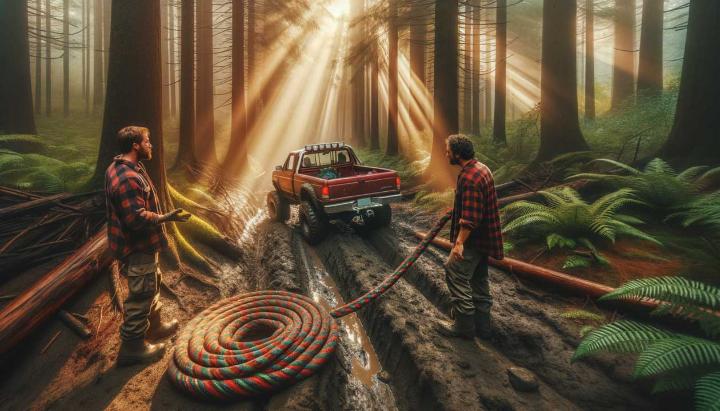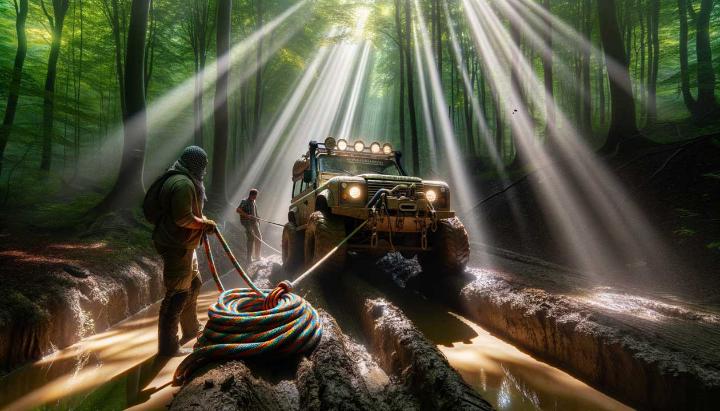Imagine yourself deep in the rugged wilderness, your off-road vehicle mired in a treacherous pit of mud. You've tried every trick in the book, but the wheels keep spinning helplessly, digging you deeper into the muck. It's at this moment you realize the importance of having the right recovery rope – a versatile, robust lifeline that could pull you out of even the stickiest situations.
In the exhilarating world of off-road adventures, where the unexpected is always lurking around the next bend, choosing the right recovery rope can mean the difference between a thrilling escapade and a harrowing ordeal. These specialized recovery winch ropes are designed to handle the immense forces involved in extracting stuck vehicles, ensuring your safety and preserving the integrity of your prized 4x4.
But not all nylon recovery ropes are created equal. With a myriad of options available, selecting the perfect rope for your needs can be a daunting task. Fear not, fellow adventurers! In this comprehensive guide, we'll delve into the essential factors to consider when choosing the best recovery rope, equipping you with the knowledge to tackle any off-road challenge with confidence and peace of mind.
Understanding the Different Types of Recovery Ropes
When it comes to off-road adventures and vehicle recovery, having the right recovery rope can mean the difference between a successful extraction and a frustrating ordeal. Recovery ropes are essential tools designed to help you tow or pull a stuck vehicle out of challenging terrain. However, not all recovery ropes are created equal, and understanding the different types is crucial for making an informed choice.
Static vs. Dynamic Recovery Ropes
Recovery ropes can be broadly classified into two main categories: static and dynamic (or kinetic) ropes.
- Static recovery ropes are designed for slow, consistent pulls over obstacles. These ropes have minimal stretch, making them ideal for situations where a steady, controlled force is required. They are commonly used in scenarios such as slowly winching a vehicle over a rock or log.
- Dynamic (kinetic) recovery ropes, on the other hand, utilize the kinetic energy of the tow vehicle to create a smoother recovery process. These ropes are designed with a certain amount of elasticity, allowing them to stretch and absorb the initial shock of the pull. This makes them an excellent choice for situations where a sudden jerk or impact is likely, such as when a vehicle is stuck in deep mud or sand.
Imagine you're out on a trail, and your buddy's truck gets stuck in a deep rut. In this scenario, a dynamic recovery rope could be the better option, as its elasticity would help absorb the initial force of the pull, reducing the risk of damage to either vehicle.

Choosing the Right Size Recovery Rope
Aside from the type of rope, selecting the appropriate size is equally important. The size of the recovery rope should be determined by the weight of the vehicles involved in the recovery process.
- General rule of thumb: For every 10,000 pounds (4,535 kilograms) of combined vehicle weight, you'll need a recovery rope with a minimum breaking strength of around 30,000 pounds (13,600 kilograms).
Using a recovery rope that's too thin or weak can lead to disastrous consequences, such as the rope snapping under the immense load, potentially causing injury or damage. On the other hand, a rope that's excessively thick or strong can be cumbersome to handle and may not provide the necessary elasticity for a smooth recovery.
When in doubt, it's always better to err on the side of caution and choose a slightly thicker and stronger rope. Remember, safety should always be your top priority when engaging in off-road adventures and vehicle recovery.
Choosing the Right Recovery Rope
When you find yourself in a sticky situation off-road, having the right recovery rope can make all the difference. Imagine yourself deep in the wilderness, your vehicle buried up to its axles in mud, and you realize your trusty recovery rope is too short, too weak, or just not up to the task. That sinking feeling sets in, and you're left wondering how you'll get yourself unstuck.
Choosing the right recovery rope is crucial for safe and effective vehicle recovery. An unsuitable rope can snap under pressure, causing damage to your vehicle or even injury. That's why it's essential to consider a few key factors when selecting your recovery rope.
Factors to Consider When Selecting a Recovery Rope
- Vehicle Weight: The golden rule is to choose a rope with a breaking strength 2-3 times the weight of the vehicle being recovered. This extra strength ensures the rope can handle the immense forces involved without failing.
- Rope Strength: Look for the rope's breaking strength and working load limit. The breaking strength is the maximum force the rope can withstand before snapping, while the working load limit is the recommended maximum weight the rope should safely handle during regular use.
- Rope Length: Longer ropes are better for kinetic recovery, as they allow for more stretch and energy absorption. Standard kinetic rope lengths range from 20 to 30 feet, but you may want to go longer if you frequently tackle challenging terrain.
- Rope Diameter: A thicker rope generally means higher strength, but it also makes the rope heavier and less manageable. Strike a balance between strength and ease of handling based on your specific needs.
- Outer Layer Durability: The outer layer of the rope takes a beating during recovery scenarios. Look for ropes with a durable, abrasion-resistant outer layer that can withstand contact with rough surfaces, rocks, and debris.

Considering these essential characteristics will help you select a recovery rope that not only gets the job done but also keeps you and your vehicle safe during off-road adventures.
Common Types of Recovery Ropes
- Kinetic Ropes: These ropes are designed with a certain amount of elasticity, allowing them to stretch and absorb the initial shock of the pull. They're the go-to choice for vehicle-to-vehicle recoveries, as their stretching ability creates a smoother, safer recovery process.
- Static Ropes: With minimal stretch, static ropes are best suited for slow, controlled pulls over obstacles or when winching a vehicle. They're great for situations where a steady, consistent force is required, but they may not offer the same level of shock absorption as kinetic ropes.
- Tow Straps: While not as strong as traditional recovery ropes, tow straps can be a budget-friendly option for lighter vehicles or shorter recovery distances. However, they lack the durability and strength of high-quality recovery ropes, so use them with caution.
Choosing the right type of recovery rope for your specific needs can make all the difference in ensuring a safe and successful recovery operation.
Safety Tips for Using Recovery Ropes
Venturing off the beaten path with your trusty 4x4 is an exhilarating experience, but it also comes with its fair share of risks. When the going gets tough, and your vehicle finds itself stuck in mud, sand, or rugged terrain, a reliable recovery rope can be your lifeline. However, using these powerful tools carelessly can quickly turn a challenging situation into a dangerous one.

That's why it's crucial to follow proper safety protocols when using recovery ropes. In this section, we'll explore some essential tips to ensure a smooth and secure recovery process, minimizing the risks to you, your vehicle, and your fellow adventurers.
Inspecting Recovery Ropes Before Use
Before embarking on your off-road journey, take a few moments to inspect your recovery rope thoroughly. Look for any signs of wear and tear, such as fraying, cuts, or broken stitching. Even the slightest damage can compromise the rope's strength and integrity, potentially leading to catastrophic failure under the immense forces involved in a recovery operation.
Additionally, make sure to check the rope's rating and confirm that it meets the necessary strength requirements for the combined weight of the vehicles involved. Using an underpowered rope is a recipe for disaster, so it's better to err on the side of caution and opt for a rope with a higher breaking strength.
Proper Techniques for Attaching Recovery Ropes
Securely attaching the recovery rope to both vehicles is paramount for a successful and safe recovery. Always use the designated tow hooks or frame points specifically designed for this purpose. Avoid attaching the rope to flimsy or fragile components, as they may not withstand the immense forces involved.
When feeding the rope through the attachment points, take care to ensure it doesn't become twisted or tangled. A neat and organized setup not only makes the recovery process smoother but also minimizes the risk of the rope becoming caught or snagged on obstacles.
Once the rope is in place, double-check that it's securely fastened and won't slip or come undone during the recovery process. Consider using additional backup safety mechanisms, such as shackles or recovery dampeners, to further mitigate the risks.
Recovery Rope Safety Precautions
During the recovery operation, maintaining a safe distance from the recovery area and the rope itself is paramount. The immense forces involved can cause the rope to snap or whip violently, posing a severe threat to anyone in the vicinity. Establish a designated safety zone and ensure that only essential personnel are present within it.
Wearing appropriate safety gear, such as gloves, goggles, and sturdy footwear, is also crucial. These protective items can help prevent injuries from flying debris or unexpected rope movements.
Clear communication between all parties involved is essential. Designate a spotter to oversee the recovery process and provide guidance to the drivers. This individual should have a clear line of sight and be able to communicate effectively with both parties, ensuring a coordinated effort.
Finally, be mindful of your surroundings and any potential obstacles or hazards that could complicate the recovery process. Consider using recovery boards or traction aids if necessary to provide additional support and stability for the vehicles involved.
By following these safety tips and exercising caution, you can enjoy the thrill of off-road adventures while minimizing the risks associated with using recovery ropes. Remember, your safety and the safety of those around you should always be the top priority.
iRopes' High-Quality Kinetic Recovery Rope Solutions
When it comes to off-road adventures and vehicle recovery, safety should always be the top priority. That's why choosing the right recovery rope is so crucial – it can mean the difference between a smooth extraction and a dangerous situation. Traditional snatch straps, while affordable, lack the durability and stretch capacity to handle the immense forces involved in recovering a stuck vehicle.
Enter kinetic recovery ropes, a game-changer in the world of off-road recovery. These innovative ropes are designed with a built-in stretch that allows them to absorb the initial shock of the pull, creating a smoother and safer recovery process. Can you imagine the peace of mind you'd have knowing your trusty recovery rope can handle even the most challenging situations without snapping or causing damage? Learn more about the differences between strong ropes and strong wire rope.

At iRopes, we understand the importance of reliable and durable recovery solutions. That's why we've invested in developing a range of high-quality kinetic recovery ropes that combine superior strength with exceptional stretch capacity. Our ropes are meticulously crafted using double-braided nylon fibers, ensuring maximum abrasion resistance and longevity, even in the harshest off-road environments.
Benefits of Kinetic Recovery Ropes
- Smooth and Safe Recovery: The built-in stretch of kinetic ropes absorbs the initial shock of the pull, reducing the risk of damage to your vehicle or the recovery point.
- Increased Durability: Our double-braided nylon construction and UV-resistant materials ensure your recovery rope can withstand the toughest conditions, from jagged rocks to intense sun exposure.
- Compact and Portable: Kinetic ropes are more compact than traditional snatch straps, making them easier to store and transport in your off-road rig. Check out our new abrasion-resistant nylon braid ropes for more details.
How to Choose the Right Recovery Rope
When selecting a recovery rope, it's essential to consider the weight of the vehicles involved and the conditions you'll be tackling. As a general rule of thumb, choose a rope with a breaking strength at least three times the combined weight of the vehicles being recovered. This extra strength ensures your rope can handle the immense forces involved without failing.
At iRopes, we offer a wide range of kinetic recovery ropes in various diameters, lengths, and strength ratings to suit your specific needs. Whether you're driving a lightweight SUV or a heavy-duty pickup truck, we have the perfect solution for you. Our ropes also come with convenient features like protective sleeves and storage bags to ensure they stay in top condition, no matter how rugged your adventures get.
Using Recovery Ropes Safely
While kinetic recovery ropes are designed for safety, it's essential to follow proper techniques and precautions when using them. Always maintain a safe distance from the recovery area and avoid overhead lifts or pulls. Inspect your rope thoroughly before each use, looking for any signs of wear or damage, and retire it immediately if you notice any issues.
For complex recovery situations or particularly challenging terrain, we recommend seeking professional guidance or training to ensure you're using your recovery rope correctly and minimizing the risks to yourself and your vehicle. At iRopes, we're committed to not only providing top-quality products but also educating our customers on safe and responsible off-road practices.
So, whether you're an experienced off-road enthusiast or just starting to explore the great outdoors, investing in a high-quality kinetic recovery rope from iRopes is a smart choice. With our commitment to durability, strength, and safety, you can tackle any adventure with confidence, knowing you're prepared for whatever obstacles nature throws your way. Explore how our high-strength 3 and 8 braid ropes can further enhance your recovery operations.
Get Your Custom Recovery Rope Today!
When it comes to off-road adventures, having the right recovery rope is essential for safety and efficiency. Understanding the differences between a kinetic recovery rope and a static one, as well as their features like the stretch and strength of nylon recovery rope, can be crucial. iRopes offers high-quality, customizable recovery winch rope solutions that meet specific vehicle needs, combining superior breaking strength, elasticity, and durability. Ensure you're well-equipped for any off-road challenge by choosing the best recovery rope from iRopes. Fill out the form above to get started on your custom solution today!